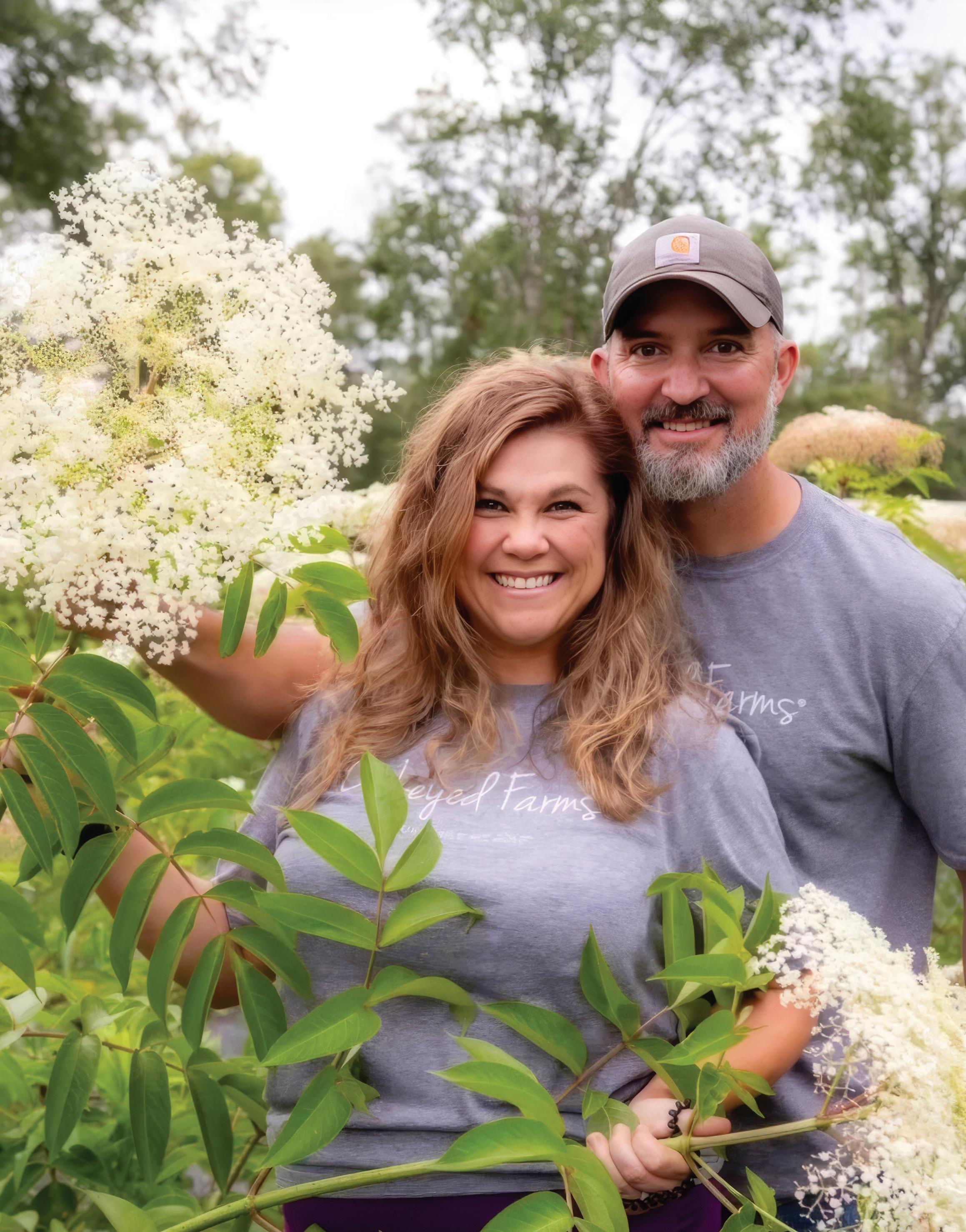

Louisiana



From Berry to Bottle
Breauxes turn 2,500-tree elderberry orchard into their family’s sanctuary Page 17

Country

PHOTO COURTESY OF COCKEYED FARMS







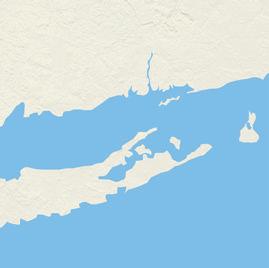





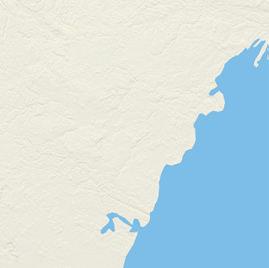
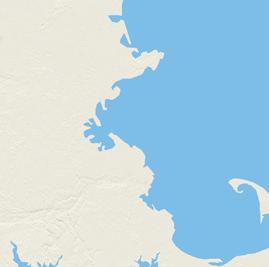
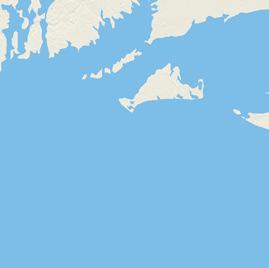







An exploration of 15 ports of call, with guided excursion options at each
All onboard meals and our signature evening cocktail hour
Full enrichment package with guest speakers and nightly entertainment
All tips and gratuities

Immerse yourself in the sights, sounds, and tastes of New England. From quaint island villages to the breathtaking beauty of the coastline, summer in New England is a truly delightful experience. Discover the region’s rich maritime heritage, savor a traditional Lobsterbake, and marvel at grand mansions of the Gilded Age. Return to the comfort of your onboard sanctuary and bask in the warm camaraderie of fellow guests and crew.
Small Town, Big Dreams
There’s a song that says, “Just a small-town girl, living in a lonely world.” And in many ways, that’s how I felt growing up in my small Louisiana town. But what I’ve learned is that even a small-town girl can dream big and find herself in places she never imagined— like Washington, D.C.
My name is Lylah Crain, and I am from Pine, Louisiana. It’s the kind of place where everyone knows your name, and on the rare chance you ever pass through, if you blink, you might just miss it.
In my little town, opportunities don’t exactly line the streets. You have to look a little harder and dream a little bigger. When opportunities like going on Youth Tour present themselves, you have to run full speed at them.
When I got the call telling me I had been chosen for Youth Tour, I was ecstatic. But I had no idea just how much this experience would open my eyes and change the way I feel about myself and my future.
It’s easy to feel small in a place like Washington, D.C. It’s a big city full of rich history and important people. But as the days went on, I came to learn that even someone from the smallest place can belong in the biggest room.
On Youth Tour, we spent a whole day on Capitol Hill.
I’ll never forget seeing that beautiful building for the first time. It was on those steps that my fellow Louisiana delegates and I got to meet Sen. Bill Cassidy. I asked him, “What is your favorite part of your job?” and he looked me in the eye and said, “Meeting people just like you.” His words inspired me and reminded me why leadership is about connection and impact.
That sense of connection stayed with me as we later met interns from Louisiana working on Capitol Hill. Hearing their stories made it clear that this isn’t just a distant dream—it’s truly possible. Their experiences encouraged me to think bigger about my own future and
imagine how I might serve and represent others one day. These experiences made me reflect on what kind of leader I truly want to be. And my thoughts led me straight back home—to my small town, where those values first took root. It’s where I learned the importance of community, the value of hard work, and the power of personal relationships. In a small town like mine, you grow up understanding that showing up for others matters, that dreams require grit, and that how you treat people will follow you wherever you go. But more than anything, you learn that real success isn’t measured by where you stand— it’s measured by who you bring with you.
Now, as the new Louisiana Youth Leadership Council Representative, I realize that I represent so much more. I don’t just represent my small town, but every small town in Louisiana and every person who has ever felt small in this big world.
Association of Louisiana Electric Cooperatives Inc.
Staff
COMMUNICATIONS COORDINATOR Conley Bourgeois
ACCOUNTING MANAGER Beth Fraser
Board
of Directors
President Michael Heinen
Vice President Roger Dale DeHart
Secretary/Treasurer Richard Sitman



ALEC Members
BEAUREGARD ELECTRIC COOPERATIVE INC.
Mike Viator Tommy Cryar
CLAIBORNE ELECTRIC COOPERATIVE INC.
Mike Marcotte Lane Davidson DEMCO
Daniel Berthelot Richard “Dickie” Sitman
JEFF DAVIS ELECTRIC COOPERATIVE INC.
Michael Heinen Byron Hardee
SOUTH LOUISIANA ELECTRIC COOP ASSOCIATION
Trevor Benoit Roger Dale DeHart
WASHINGTONST. TAMMANY ELECTRIC COOP INC. Joe Jarrell Dennis Glass
Associate Member PANOLAHARRISON

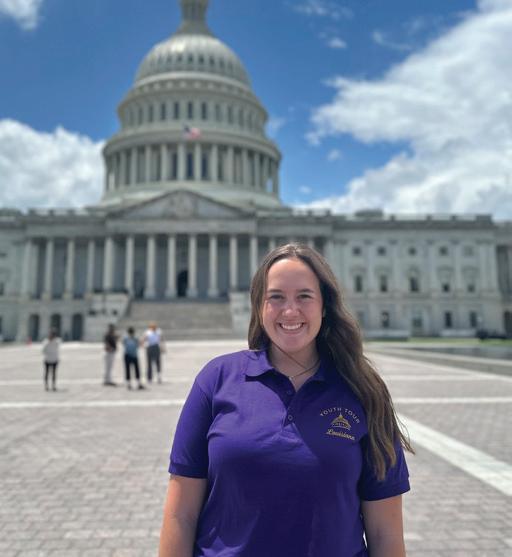
I would like to thank all of you for this amazing opportunity. Thank you for giving me the honor of representing our state. I would especially like to thank my co-op, Washington-St. Tammany Electric, for sponsoring me on the trip of a lifetime. I hope to use what I’ve learned to encourage other young people from small towns to dream big, step forward and believe they belong anywhere they choose to go.
And I would remind them of the words of the hit band Journey: “Don’t stop believin’.”
Thank you.
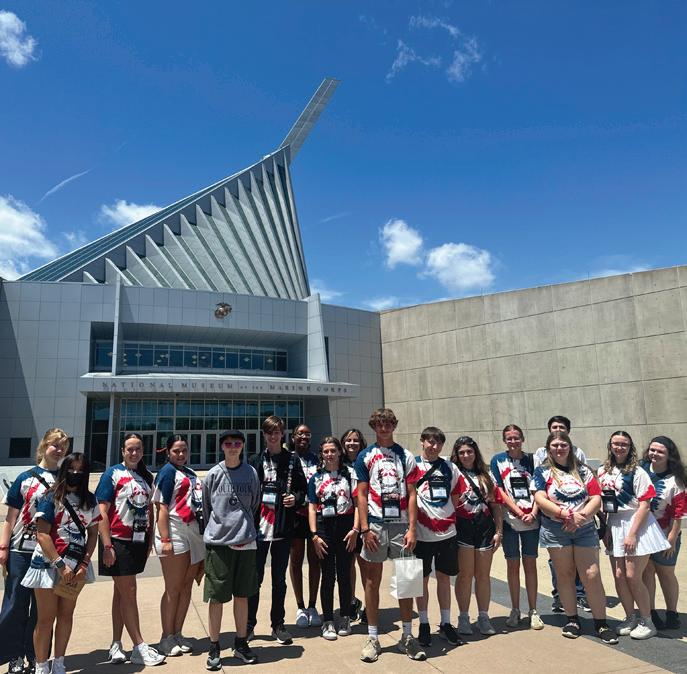
Lylah Crain is a 2025 WashingtonSt. Tammany Electric Cooperative Youth Tour delegate and Youth Leadership Council representative. She shares her YLC speech.

WASHINGTONST. TAMMANY ELECTRIC OFFICES
Main office
950 Pearl St. (P.O. Box 697)
Franklinton, LA 70438
Phone: 985-839-3562
www.wste.coop
Additional offices
21504 Mire Drive
Abita Springs, LA 70420
13526 Hwy. 40 Folsom, LA 70437
2081 E. Gause Blvd. Slidell, LA 70459
GENERAL MANAGER
Dane Hocott
BOARD OF DIRECTORS
Dr. Francis Cefalu | President
Dennis Glass | Vice President
Olander Smith | Secretary
Glenn Magee | Treasurer
Joe Jarrell Jr.
Chris Graves
Billy Wayne Rester
Charles Singletary
Nickey Smith
Volume 42, Issue 5
Louisiana Country (USPS 473-180) is published bimonthly by the Association of Louisiana Electric Co-ops Inc., 10725 Airline Hwy., Baton Rouge, LA 70816, in partnership with Pioneer Utility Resources.
Annual subscriptions: Members $2.59. Nonmembers $5.
Postmaster: Send form 3579 to 10725 Airline Hwy., Baton Rouge, LA 70816.
Periodicals postage paid at Baton Rouge, Louisiana 70821, and additional mailing offices.
The Cooperative Difference
What makes Washington-St. Tammany Electric Cooperative different from other utilities?
Unlike investor-owned utilities that serve shareholders, WSTE is a member-owned, not-for-profit electric distribution cooperative. That means decisions we make are guided not by profit margins, but by how we can best serve our members, our neighbors and our community.
Along with other cooperatives around the world, we adhere to the Seven Cooperative Principles, which guide our operations.
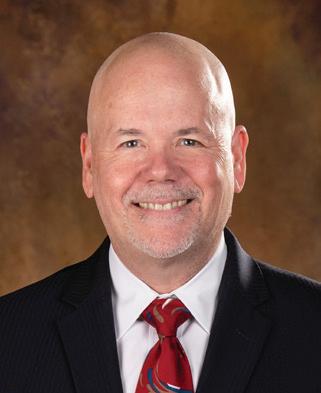
1. Voluntary and Open Membership. Membership in WSTE is open to everyone within our service territory. Everyone in our area has access to affordable, reliable electricity.
2. Democratic Member Control. Members control the cooperative through democratic processes, with elected representatives accountable to the membership.
3. Members’ Economic Participation. You, our members, contribute equitably to the cooperative’s capital, which is often common property. Surpluses are allocated for purposes such as developing the cooperative, creating reserves or benefiting members.
4. Autonomy and Independence. While we partner with other cooperatives and organizations to bring you the best service possible, we remain an independent, local business—run by and for the people in our area.
5. Education, Training and Information. We invest in ongoing education for our employees and board to ensure we stay informed and responsive. We make it a priority to keep members updated on issues that affect their service and community.
6. Cooperation Among Cooperatives. We’re stronger together. WSTE regularly partners with other electric co-ops across Louisiana and the country to share knowledge, resources and support, especially during storms and emergencies.
7. Concern for Community. This is about more than providing power—it’s about empowering people. We support local schools, sponsor youth leadership programs and engage in community service because we care deeply about the well-being of our parishes.
These principles remind me why WSTE was formed almost 90 years ago, and we still follow them today to serve you and our community. Thank you for being a part of the WSTE family.
Upcoming 2025 Office Closures
MONDAY, SEPT. 1 LABOR DAY
THURSDAY, NOV. 27 ............................................................................. THANKSGIVING FRIDAY, NOV. 28 DAY AFTER THANKSGIVING
WEDNESDAY, DEC. 24 ....................................................................... CHRISTMAS EVE
THURSDAY, DEC. 25 ..................................................................................... CHRISTMAS
The Lucky Account Number Contest continues this month with two winners included in this edition of Louisiana Country. Before you look through this edition for your winning number, find your account number printed above your mailing address. Spot that number anywhere in this issue and win $50. To claim your prize, call 985-839-3562.


Dane Hocott
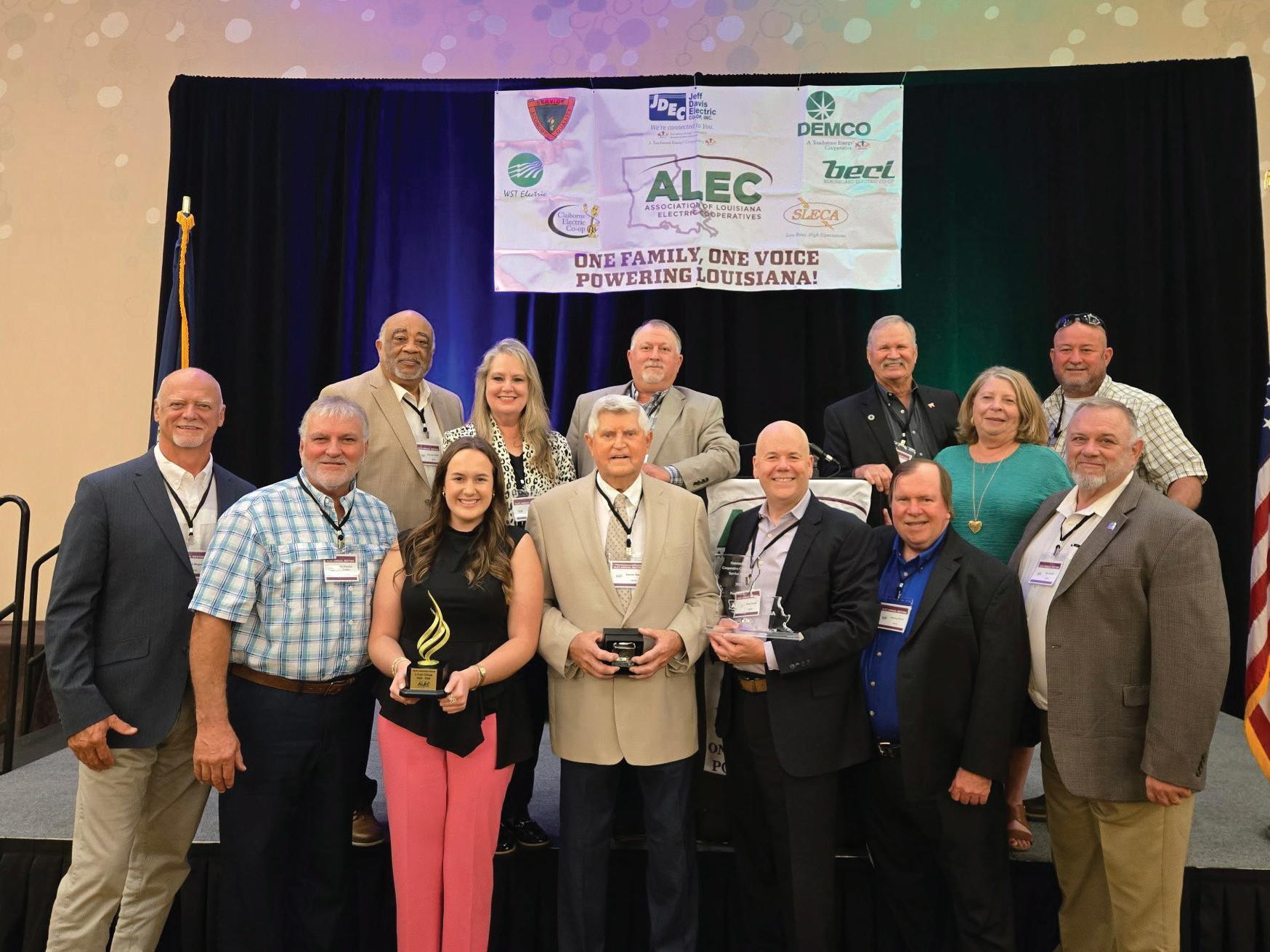
Washington-St. Tammany Electric Cooperative was honored with the Kevin Reeves Cooperative Spirit Award and recognized for no lost time hours.
WSTE Brings Home Multiple Awards from ALEC Annual Meeting
We’re proud to share that Washington-St. Tammany Electric received multiple awards at the Association of Louisiana Electric Cooperatives’ annual meeting and awards banquet in Baton Rouge.

Youth Tour
A special congratulations to our Youth Tour winner, Lylah Crain, who was selected by her peers to represent Louisiana at the Youth Leadership
Council during the 2026 National Rural Electric Cooperative Association Power Xchange meeting in Nashville, Tennessee.
Lylah spoke to WSTE’s board members, managers and employees about this incredible opportunity and was awarded a scholarship for her achievements. (Account No. 411681000)
Awards
In addition, WSTE was honored with the Kevin Reeves Cooperative Spirit Award for our employees’ outstanding volunteer work with Del Sol during the Special Olympics Summer Games. This effort reflects our commitment to one of the core cooperative principles: Concern for Community.
One of the most important awards received was for no lost time hours. Safety is always first in our business, and ensuring our employees go home safely every day is our priority. This award reflects the dedication and vigilance of our entire team.
Not All Heroes Wear Capes
Not all heroes wear capes. Some wear hard hats and drive bucket trucks.
On July 29, Washington-St. Tammany Electric lineworker Matt Smith became a hero and a guardian angel for a toddler, estimated to be 2-4 years old.
While traveling in a bucket truck along Highway 41, Matt spotted a barefoot little girl walking alone in the middle of the road. His immediate instinct was to stop traffic to prevent a tragedy.
This stretch of highway is heavily traveled, with a speed limit of 55 mph. He quickly positioned his vehicle to block oncoming cars, while others who witnessed the scene stepped in to ensure the child’s safety.
The pavement was scorching from the heat, making the situation even more urgent.
We’ve always known our lineworkers were heroes, but on this day, Matt wore his invisible angel wings.

PHOTOS COURTESY OF WSTE
WSTE General Manager Dane Hocott, left, and ALEC Communications Coordinator Conley Bourgeois, right, congratulate Youth Tour winner Lylah Crain.




















Honoring the Cooperative Spirit
LMSA and
ALEC
rename volunteer awards for Kevin Reeves; DEMCO’s Frank Fowler earns top honor
The Louisiana Member Services Association and the Association of Louisiana Electric Cooperatives recognized cooperative employees and their families for outstanding volunteer service at this year’s annual meeting. In a unanimous and heartfelt decision, LMSA members voted to permanently rename the volunteer awards as the Kevin Reeves Cooperative Spirit Awards—a tribute to a beloved Beauregard Electric Cooperative employee whose life and work embodied selfless service.
Kevin spent 33 years at Beauregard Electric. He was a friend to many in the cooperative family and a steady presence in his church and community. His unexpected death in June 2023 left a void, but his impact endures—made visible now each year in the award that bears his name.
This year’s Kevin Reeves Cooperative Spirit Award winner is Frank Fowler of DEMCO. Frank has spent nearly two decades pouring time and talent into the Good Samaritan Youth Camp—organizing activities, serving on the leadership board, recognizing standout campers, cooking, cleaning, fundraising and playing drums during worship services. His commitment to service reflects the spirit these awards are meant to celebrate. Washington–St. Tammany Electric Cooperative was also recognized with a Kevin Reeves Cooperative Spirit Award for its


2025 Individual Nominees

Frank Fowler, DEMCO—Spent nearly 20 years serving the Good Samaritan Youth Camp through programming, leadership, awards, cooking, cleanup, fundraising and music ministry.
Ty Harrington, Beauregard Electric Cooperative— Organized a St. Jude Children’s Research Hospital “Push-Up Challenge,” recruited fellow lineworkers and launched a GoFundMe campaign that drew community support and raised more than $1,000.
William Howell, Washington–St. Tammany Electric Cooperative—Director of the free “Liars and Lunkers” kids fishing tournament, first organized by his family more than two decades ago; secures sponsors and participants to





community project participation with Delo Sol at the Louisiana Special Olympics at Southeastern Louisiana University.
Safety First, Safety Always
Safety First, Safety Always
ALEC recognizes training milestones, RESAP completions and lost-time-free records
At the 2025 Association of Louisiana Electric Cooperatives Awards and Safety Banquet in July, cooperatives and individuals were honored for yearlong accomplishments in safety and training. ALEC’s safety program—one of the most relied-upon services it offers—equips employees who work in dangerous environments to do the job right and return home safely.
What RESAP Means
ALEC member cooperatives participate in the Rural Electric Safety Achievement Program—a rigorous, third-party review conducted every three years by certified loss-control professionals. The team evaluates facilities, equipment and day-to-day procedures with one goal: continuous improvement.
This year, Jeff Davis Electric Cooperative and South Louisiana Electric Cooperative Association completed the RESAP inspection and each received a flag to display at their headquarters.
ALEC commends all member cooperatives for their achievements and continued commitment to safety.
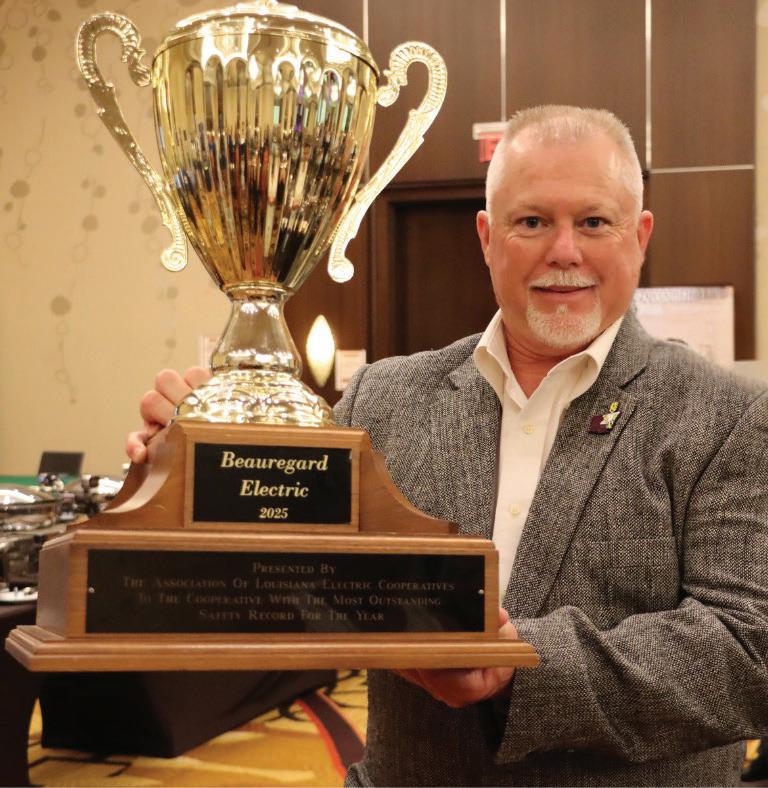
By the Numbers:
Bobby Brown, Beauregard Electric Cooperative’s vice president of operations accepted the Traveling Statewide Safety Award on behalf of BECi. The winner is determined by a formula that weighs employee incidents, incident severity, total man-hours and vehicle accidents.
LOSTTIMEFREE MILESTONES
ALEC recognized member systems that worked without a lost-time accident:
• South Louisiana Electric Cooperative Association—More than 4,715,603 work hours since December 1996
• Beauregard Electric Cooperative—More than 555,979 work hours since November 2022
• Claiborne Electric Cooperative—More than 827,780 work hours since June 2024
• Washington–St. Tammany Electric Cooperative More than 249,132 work hours since April 2024
(A lost-time accident is an incident that results in an employee missing work beyond the day of injury.)

Mini-Grant Opportunities Available for Local Educators
Washington-St. Tammany Electric Cooperative will issue $500 mini-grants for educational opportunities for children in its service territory to help teachers and schools enhance learning in the classroom.
“All grades in the three parishes we serve—St. Tammany, Tangipahoa and Washington—will compete with other teachers to receive this grant,” says Coylean Schloegel, WSTE manager of marketing and economic development. “This is just one of the many programs offered by WST to the education of our children.”
Who is Eligible
Any K-12 classroom teacher whose school is within a community served by WSTE or whose students’ homes are served by the co-op can apply. Visit www.wste.coop and click on the Community Outreach tab. Follow the instructions under minigrants. (Account No. 10005100)
How to Apply
K-12 teachers can visit wste.coop and click on the Community Outreach tab to learn more.
Submit a one- to two-page proposal by 4 p.m. Nov. 11, 2025, describing what you and your students will investigate.
Mail to ATTN: Coylean Schloegel WSTE Mini-Grants
P.O. Box 697
Franklinton, LA 70438
Email to cschloegel@wste.coop.
If Your Hands, Arms, Feet, or Legs Are Numb - If You Feel Shooting or Burning Pain or An Electric Sensation - You Are at Risk
Don't Let Creeping Nerve Death Ruin Your Life
Get The Help You Need - Here's What You Need to Know...
Purvis, MS - If you experience numbness or tingling in your hands, arms, legs, or feet or if you experience shooting or burning pain, this is important.
Please read this carefully.

Peripheral Neuropathy is when small blood vessels in the hands, arms, feet or legs become diseased and tiny nerves that keep the cells and muscles working properly shrivel up and die.
Early-warning symptoms include tingling and numbness, mild loss of feeling in your hands, arms, legs or feet, inability to feel your feet, which increases your risk of foot-injury and falling.
More Advanced Symptoms Include...
Loss of coordination & dexterity, which puts you at increased risk of accidents.
Inability to feel clothing like socks and gloves.
High risk of falling, which makes walking dangerous, and makes you more dependent on others.
Burning sensations in your arms, legs, hands or feet that may start mild, but as nerves and muscles die, may feel like you're being burned by a blow torch.
Ignore the early warning signals long enough and you risk progressive nerve damage leading to muscle wasting, severe pain, loss of balance and a lot of staying at home wishing you didn't hurt.
When every step is like walking on hot coals, sitting still may be the only thing you feel like doing. But there's little joy in sitting still all day long.
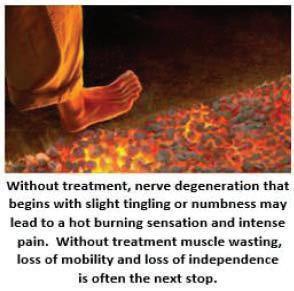
Now here's the scary part....
Nerve damage CAUSES cell damage.
Cell damage SPEEDS UP nerve degeneration
Without treatment this can become a DOWN-WARD SPIRAL that accelerates.
The damage can get worse fast. Mild symptoms intensify. Slight tingling, numbness or lack of feeling can turn into burning pain.
Before you know it, damage can become so bad you hurt all the time.
Unless this downward spiral is stopped and nerves return to proper function - the damage to nerves and cells in the affected area can get so bad your muscles begin to die right along with the nerves and cells. And that sets the stage for weakness, loss of mobility, disability, and dependence on others.
If you have early warning signs of peripheral neuropathy, (tingling &/or numbness, loss of feeling or pain) it's CRITICAL you get proper treatment. It's critical, because with proper treatment the symptoms can often be reversed. Without it, you are playing Russian Roulette with your health.
Once your nerve loss reaches 85%, odds are there's nothing any doctor can do to help.
The most common method your doctor may recommend to treat neuropathy is prescription drugs

Drugs like Gabapentin, Lyrica, Cymbalta, & Neurontin are often prescribed to manage the pain. But, damaged nerves and dying cells do not heal on their own.
Pain pills do not restore healthy nerve function. They just mask the pain as the nerves continue to degenerate and cells and muscle continue to die.
Taking endless drugs and suffering terrible side effects that may damage your liver & kidney and create even more problems, is not a reasonable path. You deserve better.
Three things must be determined to effectively treat neuropathy. 1) What is the underlying cause? 2) How much nerve damage has been sustained? 3) How much treatment your condition will require? With proper treatment, shriveled blood vessels grow back & nerves can return to proper function. How much treatment you may need depends on your condition.
At Purvis Chiropractic we do a complete neuropathy sensitivity exam to determine the extent of your nerve damage. The exam includes a detailed sensory evaluation, extensive peripheral vascular testing, & a detailed analysis of the findings.
Dr. Rob Acord, D.C. will be offering this complete neuropathy sensitivity exam for $47. This special offer goes away at the end of this month as we have a limited number of exam appointments available. Stop Hurting & Start Healing Call







Overlooked Opportunities
Largely ignored game birds can provide fast action
Story and photos by John N. Felsher
As the pirogue pushed forward through flooded reeds, birds exploded in all directions.
“Shoot!” I yelled. “There’s another one. Fire! One stayed in the reeds. Here he comes. Shoot again.”
In seconds, my young son pumped out three rounds from his new Remington Model 870 20 gauge. More birds flushed from dense cover as others raced into the canes to escape on foot.
“Look, there goes more birds,” I said. “They are all over the place. Get that one running across the water.”
Hastily dropping one shell into the chamber, my son cartwheeled another slate-gray bird struggling to get airborne.
We watched where most of the birds landed not far away. We picked up our kills and took a brief break. Minutes later, reloaded and recomposed from the adrenaline rush, we began another stalk. We repeated this until my son soon bagged his limit.
The Bayou State offers hunters long seasons and very liberal limits for abundant, but largely ignored, fowl. Even many experienced hunters don’t know what rails and gallinules are, so
few people intentionally pursue these magnificent, overlooked game birds.
In the Sportsman’s Paradise, king, Virginia and sora rails, and purple and common gallinules share freshwater marshes, reedy lake shorelines, sluggish sloughs, river backwaters and other wetlands with thick grasses growing in or near the water’s edge. Clapper rails prefer salt marshes. Hunters along the coast often hear clappers cackling from their dense vegetative lairs.
Rails and gallinules can fly and swim, but they typically prefer to run into high weeds to escape danger. To become airborne, gallinules must patter across the water like coots. These chickenlike fowl habitually drop into impenetrable grass clumps or cane thickets after flying for just a few yards. With their long toes, gallinules nimbly dance over floating lily pads, water hyacinths or other matted vegetation. Unlike loner rails, gallinules sometimes congregate in flocks while swimming in shallow coves or walking across matted grass.
Rails and gallinules do not respond to decoys or calls, so hunters must go looking for them. Slogging through mushy Louisiana wetlands takes considerable effort. Therefore, small
boats provide the fastest, easiest and best way to hunt these birds.
Federal law prohibits anyone from shooting at migratory birds from boats under power or sail, but hunters can use paddle or pole boats to hunt gallinules and rails. Many people use canoes, pirogues or kayaks, but hunters could pole or paddle small motorized boats if the motor stays off and all forward momentum from the motor ceases.
When hunting alone, put the gun in a safe, convenient place for easy access when targets appear. For the most fun, try doubleteaming the birds. Position the shooter in the bow. The person in the rear serves as the primary paddler and spotter. People could switch positions periodically if they wish.
Paddling after rails and gallinules offers an outstanding way to interest youngsters or novice hunters. In the bow seat, a youngster can sit in relative comfort and usually expect action. On a good day, hunters might spot dozens of birds and fire quite a few times. In addition, hunters can carry food and refreshments in the boat to take occasional breaks.
Whether alone or in teams, paddle or pole through lake sloughs and small marshy channels with matted aquatic vegetation and abundant tall reeds growing along the banks. Stick close to the shoreline. As silently as possible, dip paddles into the water and listen for the distinctive cackling or feet pattering over the surface.
Scan exposed mudbanks and grassy edges for movement. Using stealth and camouflage rather than wings, rails and gallinules normally freeze to avoid enemies. Even if the boat passes within a few feet of them, they might not move.
If birds dart into thick reeds, paddle about 30 yards away and wait quietly. Often, they come back to the shoreline after a few minutes. Sometimes, curious birds peek out to see if the danger has passed. If the birds don’t reappear, remember that spot and return to it later. Except when migrating, rails and gallinules seldom venture far from their reedy home territories.


Use small, weedy islands, tall canes, fallen trees or other available cover to hide the boat as much as possible. Take the inside curve on any bend and stay as hidden as possible. When rounding bends or emerging from behind tiny islands, birds could appear or flush at any second.
Since rails and gallinules seldom see much hunting pressure, hunters might approach fairly close to them. Even after shotguns are fired, some gallinules might remain in place. The birds believe they can better avoid danger by keeping still rather than flying.
Hunters may be able to bag two or three gallinules before other nearby birds become nervous and scatter. After shooting one or two, hunters could pick off stragglers running across the water to get airborne.
Even after flushing, the birds seldom fly far. After busting a flock of gallinules, eat a snack and enjoy a refreshing drink. Let the birds settle down a bit. Then, begin stalking them again. In good habitat with abundant bird populations, hunters won’t need to travel far to find more action and seldom encounter other gallinule or rail hunters.
A 20- or 28-gauge shotgun makes an excellent rail or gallinule buster. Even a .410 can easily take down these birds without destroying too much meat. Most shots occur at less than 30 yards.
Gallinules and rails traditionally stay active during most of the day, so hunters don’t need to start hunting them at first light. When gallinule and rail seasons run concurrent with teal or waterfowl seasons, many people hunt ducks at dawn. When the ducks stop flying, paddle after some rails or gallinules, especially when hunting with youngsters.
On days when ducks won’t fly, a limit of gallinules can turn a humdrum morning into an exciting, memorable adventure, particularly for a young shooter.
A pair of common gallinules find a vegetation clump in a large grassy backwater in a marsh. Although few people hunt them, gallinules can provide great sport, especially for small children or novice hunters.
One common gallinule runs along the water to take off while the other one swims in thick grass.



Memories Making



Students gain knowledge, appreciation and friendships during Youth Tour
By Trish Milburn
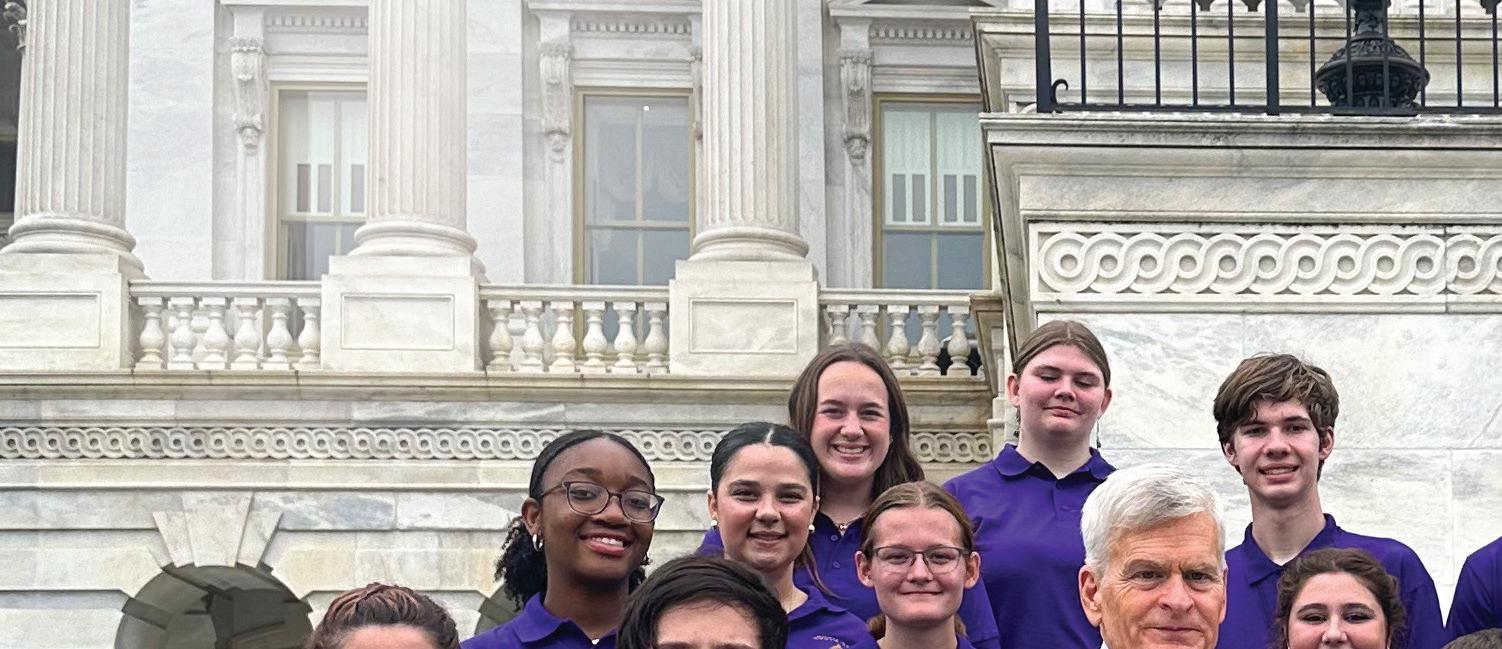





Louisiana’s 2025 Youth Tour delegates gather with Sen. Bill Cassidy on the steps of the U.S. Capitol.

There is something particularly awe-inspiring about visiting places you’ve only ever seen on television or the internet. They seem somehow real and unreal at the same time.
This is part of the experience for many students who take part in the Youth Tour of Washington, D.C., sponsored each summer by the National Rural Electric Cooperative Association, statewide cooperative associations and local electric cooperatives. Whether it’s being moved by the expanse of Arlington National Cemetery and the sacrifice it represents, viewing the countless wonders housed in the Smithsonian Institution museums or standing on the steps of the U.S. Capitol, a tour of the nation’s capital makes a lasting impression.





“One of my favorite things from the tour was seeing all the monuments: The Washington Monument, Lincoln Memorial, U.S. Marine Corps War Memorial, World War II Memorial, the Martin Luther King, Jr. Memorial and the Korean War Veterans Memorial,” says Lillie Lynch, a Louisiana delegate who represented DEMCO, her local electric cooperative, on the 2023 tour.



over the past five-plus decades. These students were sponsored by their local electric cooperatives for this once-in-a-lifetime experience.















Samantha Parks, a 2025 tour delegate representing Beauregard Electric Cooperative Inc., was also struck by the monuments—one in particular.



“The Lincoln monument was particularly memorable for me,” she says.













The students also became part of a rich history that goes all the way back to the moment at the 1957 NRECA annual meeting when the guest speaker, then-Sen. Lyndon B. Johnson, suggested that “if one thing comes out of this meeting, it will be sending youngsters to the national capital where they can actually see what the flag stands for and represents.”
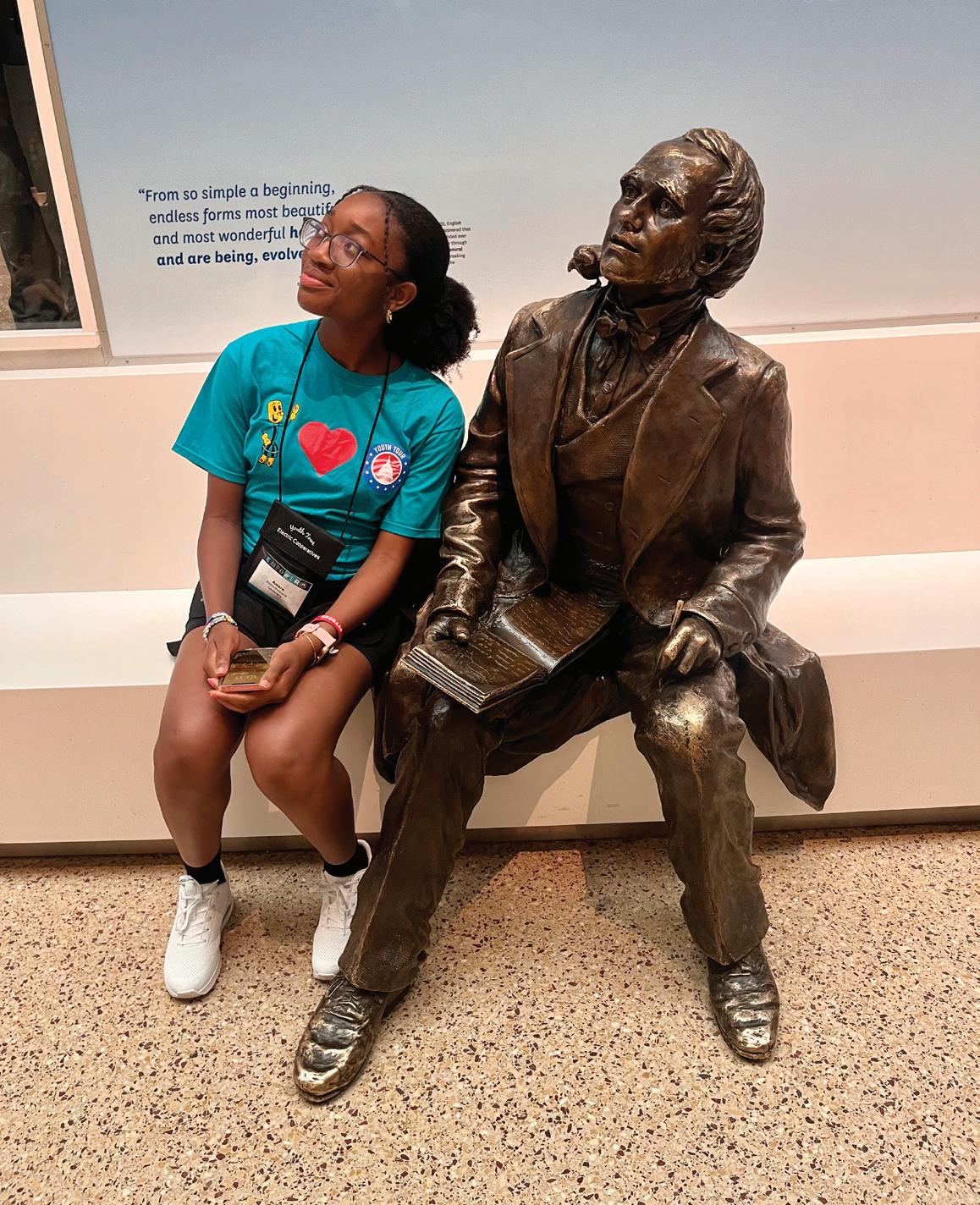

That summer, Johnson’s home state of Texas was the first to have a few electric co-ops send students to D.C. The following year, Iowa and then Illinois sent delegations to the nation’s capital. In 1964, NRECA began to coordinate the trips for state delegations, which numbered 12 that year with a total of about 400 delegates.





The Tour Today Participation numbers have increased dramatically in the intervening years as new states, including Louisiana, began to send delegates. As of 2025, 44 states take part by sending about 2,000 students and electric cooperative staff members on the tour each year.



The Youth Tour isn’t just a sightseeing trip, however. Its main purposes are to give rural high school students a deeper understanding of the history of the United States, American democracy and the role of electric cooperatives. There is a strong educational component to encourage active participation in democracy, foster the delegates’ understanding of their role as citizens and help develop leadership skills.
The Beginning









“I’ve had the opportunity to go on this trip three times, and each year is a completely different experience,”
ALEC Communications Coordinator Conley Bourgeois says. “While we visit many of the same sites, it’s the students and the energy they bring that make every trip unique. For some, it’s their first time leaving their hometown or the state of Louisiana. Getting to explore the nation’s capital and its rich history is truly eye-opening.


“Beyond the monuments and museums, we focus on teaching valuable life skills like time and money management, things they’ll carry with them into college and adulthood,” she says. “It’s so much more than just a trip to D.C. It’s a life-changing experience that helps shape their future.”

When the Association of Louisiana Electric Cooperatives took 15 student delegates on the tour in June, they became part of the approximately 2,000 delegates who have represented Louisiana












Conley believes one of the biggest impacts of the tour experience is giving students the chance to meet and talk with Louisiana’s congressional delegation and their staff members.










































Amara Nwabueze, a 2025 DEMCO delegate, sits with a statue of Charles Darwin in the Smithsonian National Museum of Natural History.



“Getting that one-on-one time with people they’ve only seen on TV or heard about in class is unforgettable,” she says. “For some of them, this might be the first time they’ve ever met one of their local lawmakers and that’s something they won’t forget.”










That perspective from the chaperone side of the equation bears out on the delegate side.
“We got to meet with multiple representatives from Louisiana, but I specifically enjoyed meeting Julia Letlow, my representative,” Lillie says. “I think I gained a whole new appreciation for the history of our country. Getting to see things that I had heard about before in history class but never experienced gave me a new sense of interest and reverence for our history.”







Conley says Capitol Hill day was a major highlight of the trip for students.
and later to delegates of the next Youth Tour. All members of the YLC are invited to attend the NRECA annual meeting.

Just like during the Youth Tour, the YLC participants also get to enjoy some fun activities such as baseball games, ghost walks and unique dining experiences.

Madelyn Bailey, who represented Beauregard Electric Co-op during the 2024 Youth Tour, was chosen as last year’s YLC representative. From the moment she found out she was selected to go on Youth Tour, she says she knew she wanted to go a step further and apply for the YLC.


“We had the chance to meet with our congressional staffers and talk about internship opportunities for college students,” she says.
“The delegates were really engaged and asked great questions. Many of them are now interested in returning to D.C. to intern on the Hill while in college and are eager to gain more life and leadership skills through experiences like this.”

Leaders Among Leaders

Each year, one student from each state is chosen for the Youth Leadership Council. These 44 students return to Washington, D.C., for an additional week in July to take part in leadership workshops and educational programs about electric cooperatives. Also on the agenda are motivational speakers and visits to the headquarters of NRECA and the National Rural Utilities Cooperative Finance Corporation, a nonprofit finance cooperative that provides financial services to electric cooperatives.

“By participating on the council, I was able to not only represent the great state of Louisiana, but also able to represent my small town and prove that big things can come from small towns across America,” Madelyn says. “While serving as the Louisiana YLC representative, I had the opportunity to learn so much about not only myself, but also others. I now understand what type of leader I am and how that can be used to work alongside others in various tasks. This is now information that I use daily to know when I need to step up in a situation or let someone else take the lead.”
New Friendships




Delegates also choose one participant to be the YLC national spokesperson, who will give a speech at the NRECA annual meeting
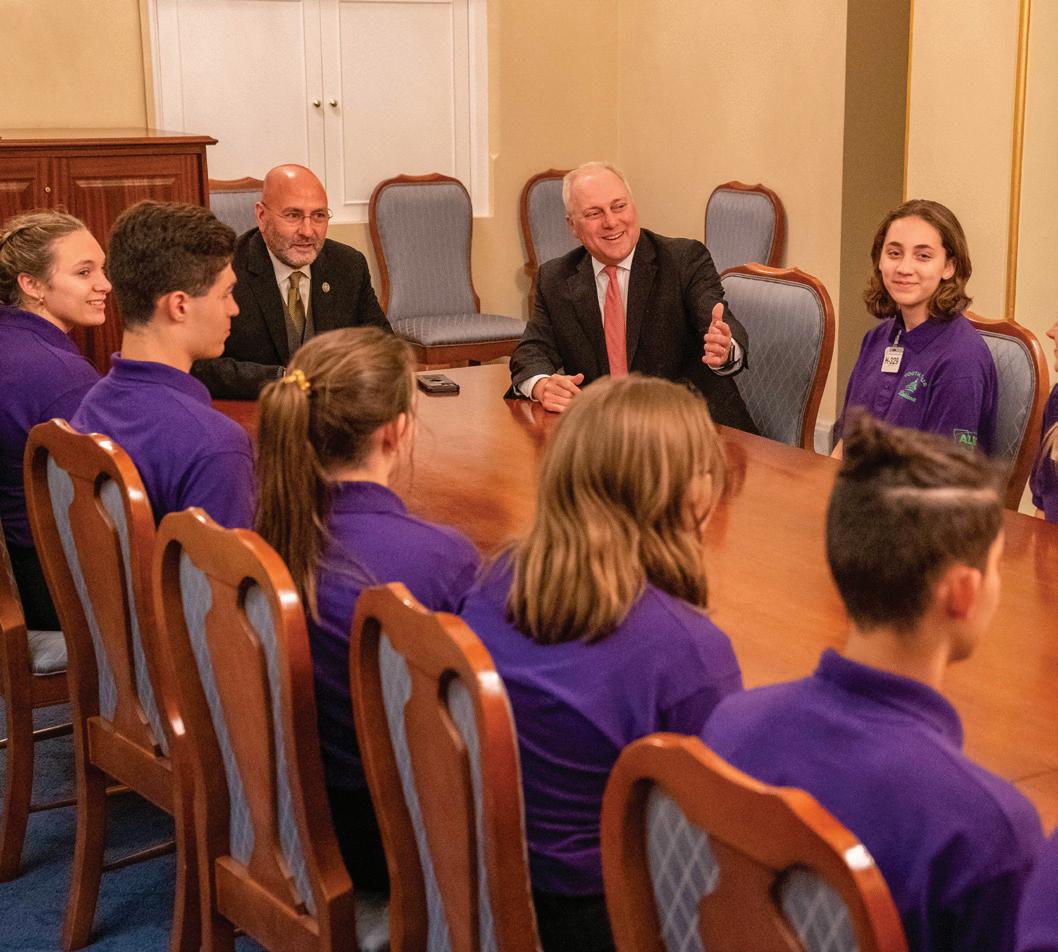








Other than seeing the sights in Washington, D.C., and learning from various leaders, Youth Tour students are quick to mention they enjoy the new friendships they form over the week. This friendmaking process isn’t just fun, however. It has lasting benefits as well.

“I genuinely learned a lot about making friends,” Lillie says. “I came into the Youth Tour with no one else from my school, but I was so blessed to meet many other people including the other participants from my co-op, and now we still try to see each other once or twice a year. I was able to use this experience of making friends when I decided to go out of state for college where I knew maybe three other people. The tour prepared me to be bold and put myself out there when meeting new people.”
Madelyn agrees with Lillie’s take on the specialness of Youth Tour friendships.
“My absolute favorite thing was getting to meet so many new people who share the same interests as me and making lifelong connections and friendships with many of them,” she says.
2025 Youth Tour Delegates
Beauregard Electric Cooperative Inc.

Samantha Baker, Audrey Bryant and Samantha Parks






Jeff Davis Electric Cooperative

Heath Hardesty and Khye Hornsby


South Louisiana Electric Cooperative Association
Madeleine Boudreaux and Presley Blanchard


Washington–St. Tammany Electric Cooperative
Lylah Crain and Holly Melton








DEMCO
Elliana Overton, Ashlynn Voytas, Amara Nwabueze, Isabella Farris, Jet Kroll and Jakob Farrar
Louisiana’s 2023 Youth Tour delegates meet with Reps. Steve Scalise and Clay Higgins.



Samantha found the diversity of experiences and perspectives among the participants especially interesting.
“One of the most significant takeaways from the tour was the importance of reaching out and forming connections with others,” Samantha says. “I realized that you can quickly form strong bonds with people if you’re willing to try, and everyone has more depth to them than initially meets the eye. I’m looking forward to applying this lesson in college, where I hope to be more outgoing and build meaningful relationships, rather than sticking to my usual reserved nature.”




Conley witnesses the friendships blooming and strengthening on each year’s tour.



“Even for those who have been to D.C. before with family or school, this trip is still incredibly special. It’s different,” she says. “Traveling with about 15 other delegates from across Louisiana, spending seven days together on a bus, learning about the cooperative business model, gaining valuable life skills and stepping outside their comfort zones, all of that creates something unique. Along the way, they build lifelong friendships and unforgettable memories. Then there’s Youth Day, where delegates join students from 44 other states to trade pins and connect with peers from all over the country. Whether it’s your first time in D.C. or not, this trip truly is a once-in-alifetime experience.”



The Youth Tour can even help set a new path for participants’ futures.
Samantha, who just began her freshman year at Northwestern State University’s Scholars’ College in Natchitoches, decided to pursue a degree in criminal justice.
Words of Wisdom

“The Washington Youth Tour experience has also inspired me to explore study abroad programs, fueling my desire to engage with diverse cultures and perspectives globally,” Samantha says.






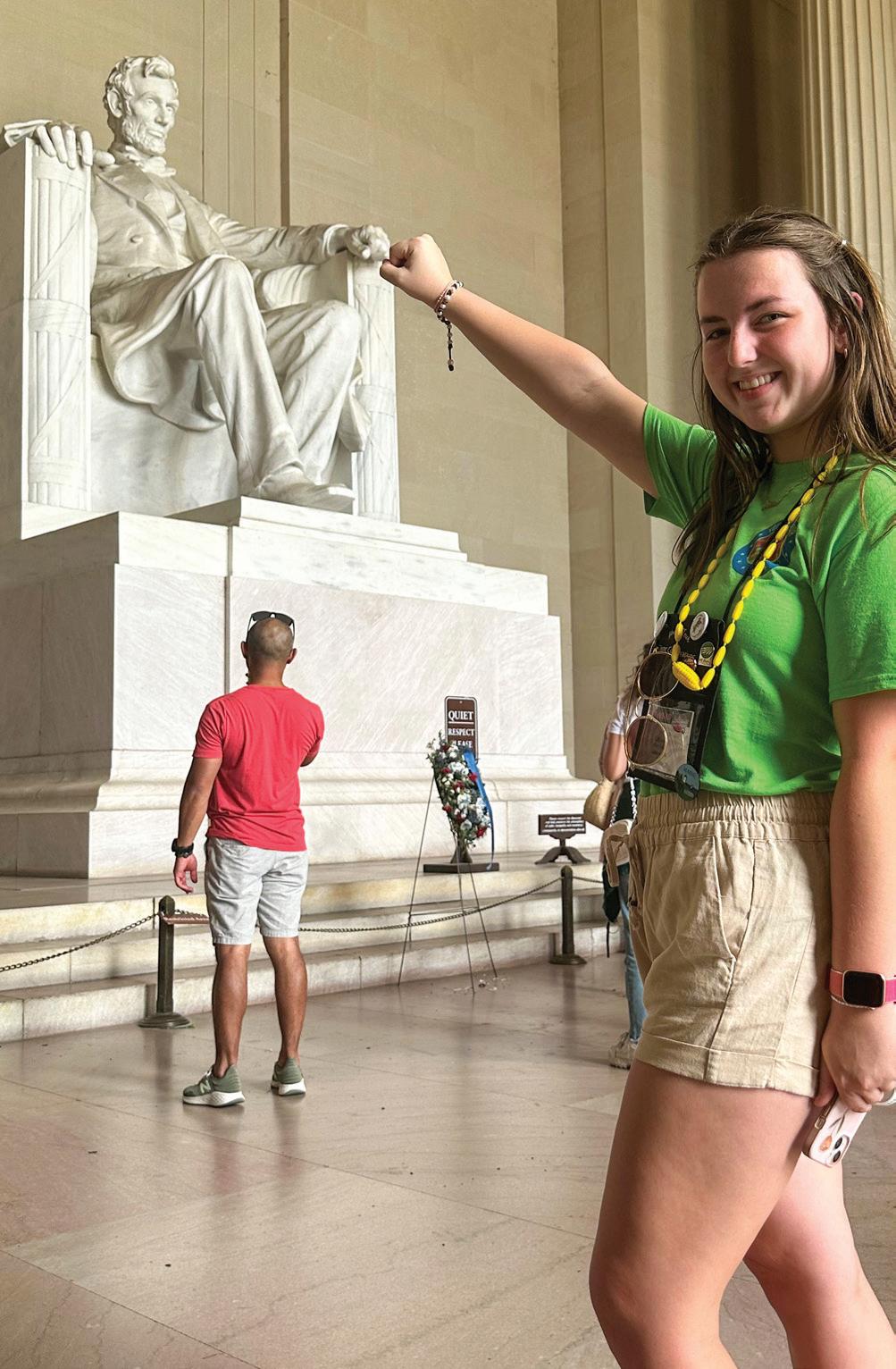


While the friendships, leadership workshops, deep dive into the history and current efforts of electric cooperatives, and aweinspiring sights make indelible impressions on these young Louisianans, sometimes it’s a simple, unexpected phrase that really hits home and becomes a guiding light as they progress through the rest of their formal education and then into lives as young adults.
Madelyn says one of the most impactful things she learned came from one of the keynote speakers, Mike Schlappi, a multiple Paralympic medalist and motivational speaker.






“During his speech, he told us, ‘Takers eat well, but givers sleep well,’” she says. “To this day, this excerpt still truly resonates with me. As a leader within my community, it is important to have a reminder that giving to others will take you much further in life than taking what others deserve.”























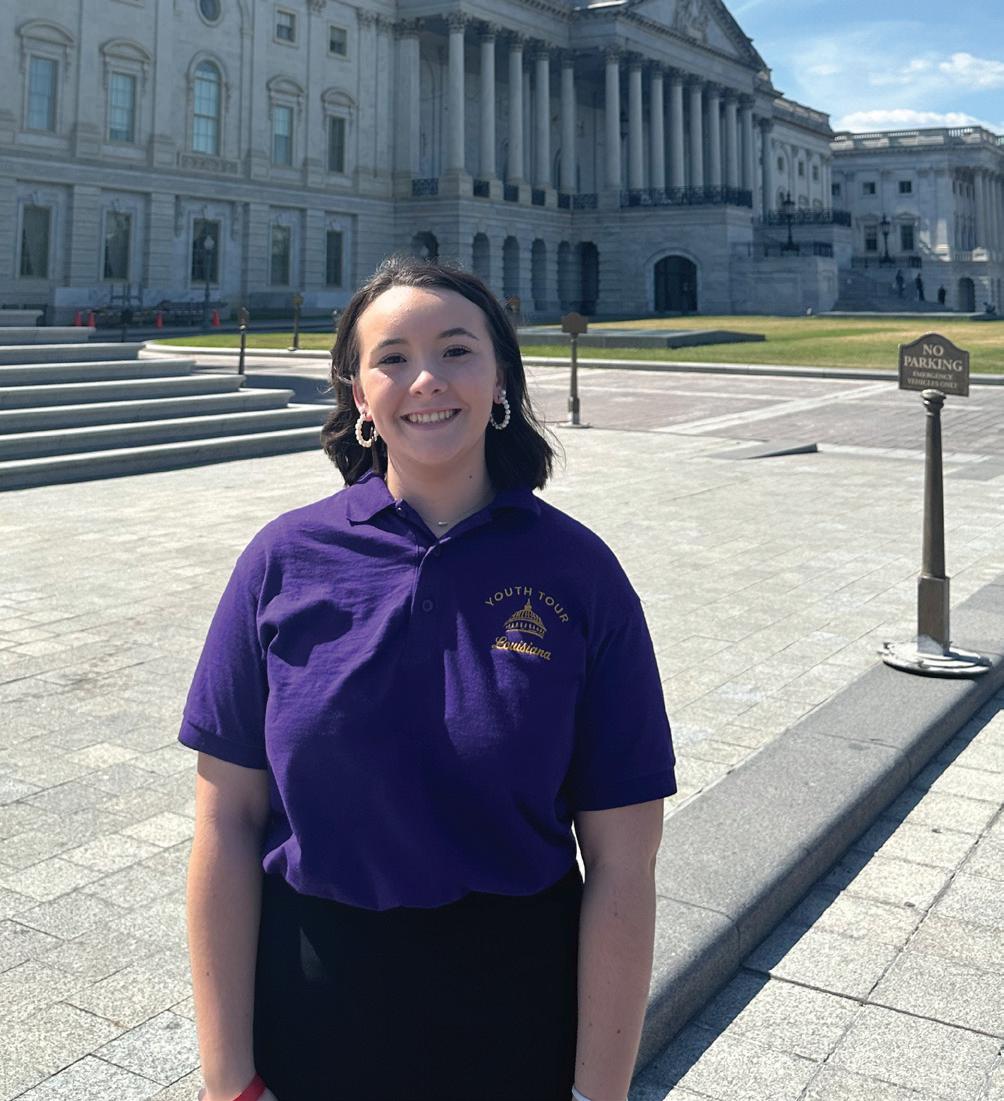




































































RIGHT: Lillie Lynch, a 2024 DEMCO Youth Tour alumna, fist bumps the Abraham Lincoln statue inside the Lincoln Memorial. BOTTOM RIGHT: Beauregard Electric Cooperative Inc.’s 2024 Youth Leadership Council representative, Madelyn Bailey, stands in front of the U.S. Capitol.















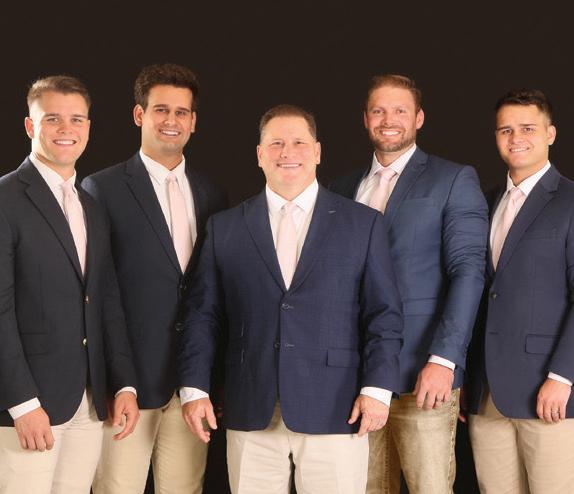


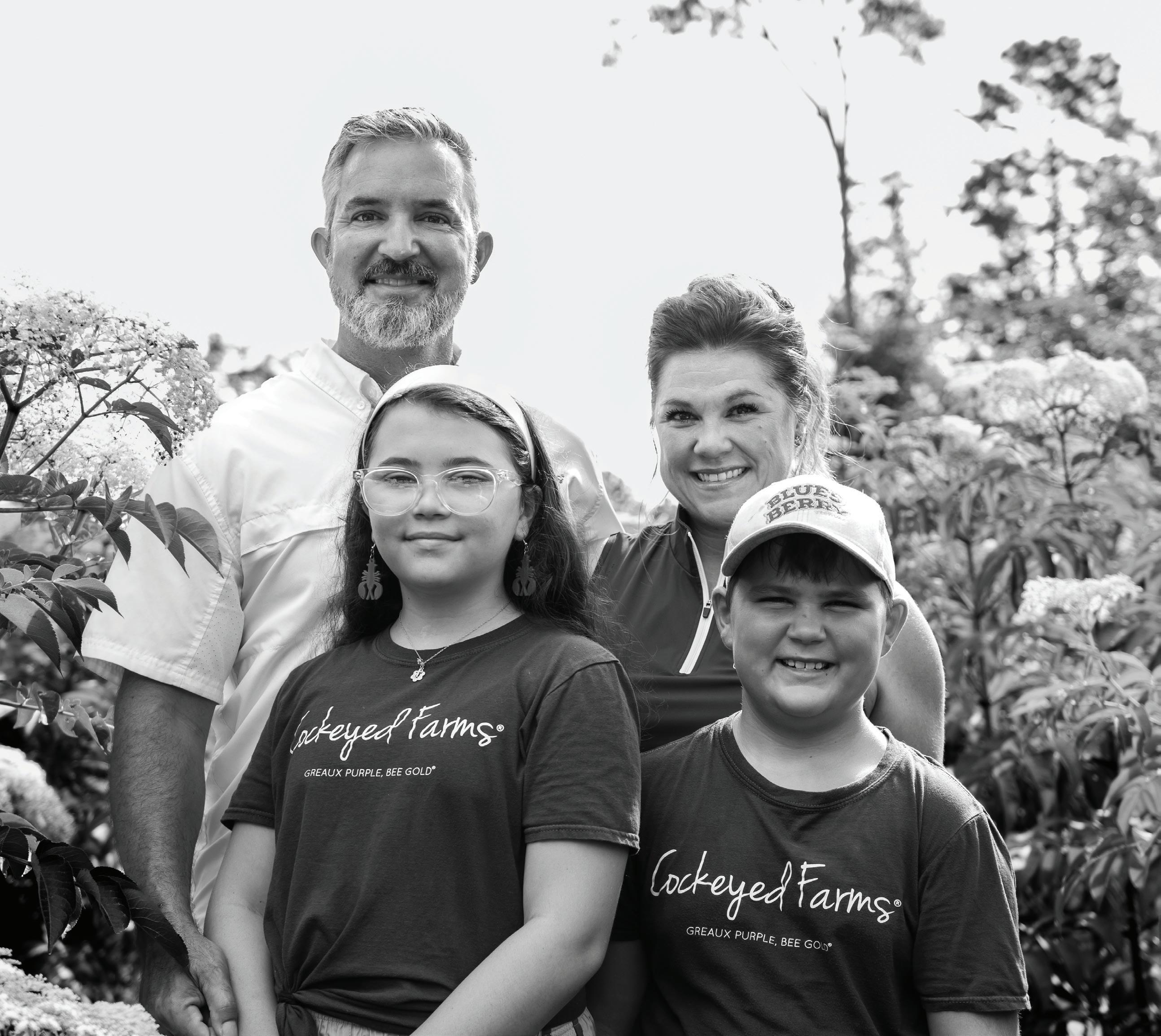
From Berry to Bottle
Breauxes turn 2,500-tree elderberry orchard into their family’s sanctuary
By Mimi Greenwood Knight
Serving others is nothing new to Brandon Breaux. He served his country as an OH-58D scout attack helicopter pilot in Iraq. Brandon was exposed to chemical weapons, leaving him with Gulf War rashes, masses growing in his neck and shin, vertigo, and debilitating cluster headaches. This ended his aviation career and medically retired him from military service. However, the prescription medication he was taking made him realize he had to make some life changes.
“I was taking 14 prescription medications a day. It was destroying my immune system, and my gut was a mess,” Brandon says.
With two small children at the time, his priority was to be around to watch them grow up. So, he had to make a change.
Brandon and his wife, Lauren, talked for years about buying land close to family. So, they bought an 85-acre cattle farm.




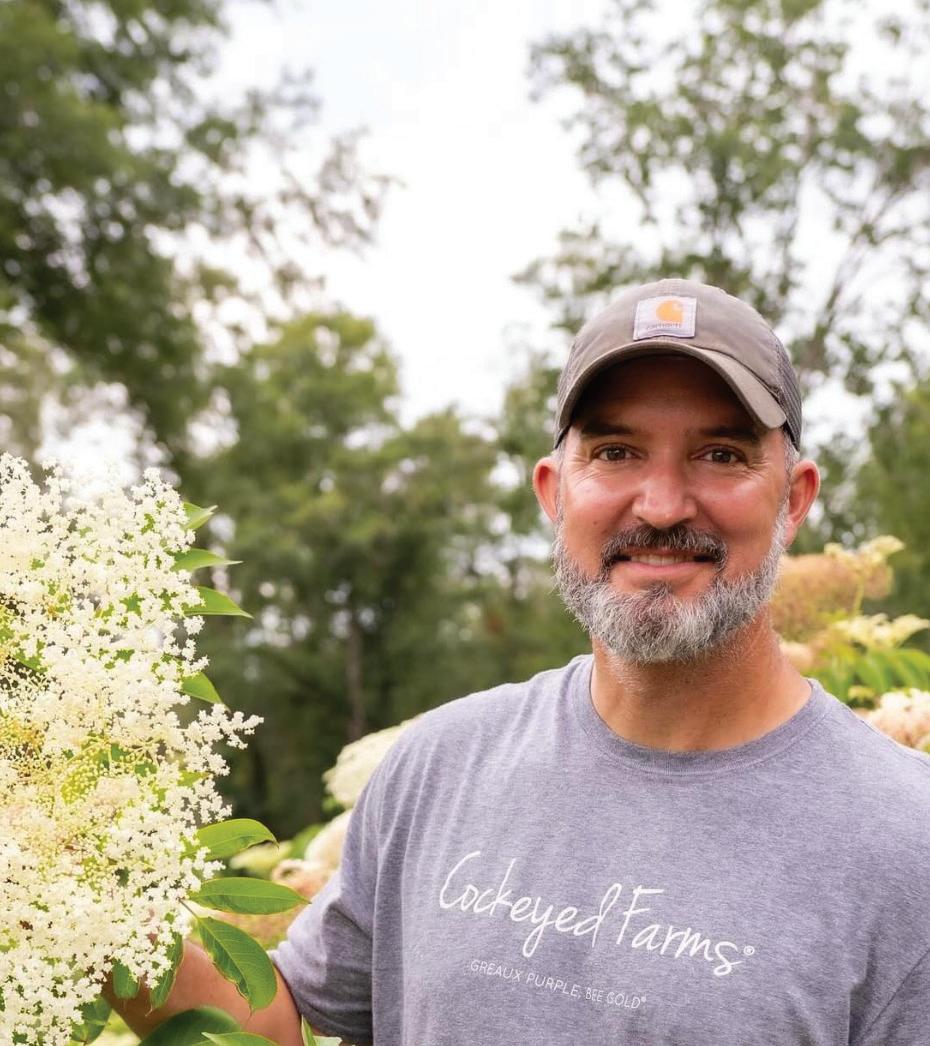



Continued from page 17
“Lauren put me on a keto diet to heal my gut, and I got off of all medication,” he says. “As we did more and more research, we realized the food we were eating was the most significant influence on our overall health.”
Brandon researched and realized what he needed was a diet high in antioxidants. The family began eating only organic food.
One day while riding around the property, Brandon noticed elderberry growing wild. The benefits of elderberry had appeared, more than once, during his research. He knew it was high in antioxidants. That’s when he dove down the rabbit hole of all rabbit holes. When Brandon finally came up for air, he had learned elderberries thrive on neglect and don’t mind poor soil conditions.
“Sounded like the perfect crop for a first-generation farmer,” he says.
When he read there would be an elderberry conference in two weeks in Missouri, he was on his way to learn all he could about becoming an elderberry farmer. Lauren was 100% behind the idea.
Brandon learned 98%-99% of elderberries in the United States are imported from Europe, even though the trees grow like a weed in the states. He further learned the imported European variety, sambucus nigra, is nutritionally inferior to the variety that’s native to North America, sambucus canadensis.
“The European variety actually contains toxins—including cyanamide—that can only be neutralized by pasteurizing it at high temperatures,” he says. “Unfortunately, those high temperatures destroy many of the nutritional benefits of the elderberry.”






Brandon read that extensive research by the University of Missouri established that American elderberry contains a negligible amount of these undesirable toxins, as well as containing other nutrients that have established elderberry as a super food, including triple the antioxidants of blueberries.


Research also established American varieties have seven antioxidants while the European varieties contain four. The American variety retains more of the nutritional value when pasteurized than its European





“Talk to any nutritionist or dietician and they’ll tell you to eat fruits with the word ‘berry’ in the name, and the darker the berry, the better it is for you,” Brandon says. “That dark color indicates antioxidants, flavonoids and polyphenols with elderberry being the cream of the crop.”








Those antioxidants, flavonoids and polyphenols help protect the body against damage from free radicals, potentially reducing the risk of chronic diseases. Brandon learned during his research that they have anti-inflammatory, anti-diabetic and neuroprotective properties, and they are associated with improved cardiovascular health and reduced risk of some cancers.


Brandon and Lauren decided their family was going to become elderberry farmers. And they’d do it organically.
And
“I started volunteering on organic farms in Missouri and Arkansas, learning all I could,” Brandon says. “We hired a consultant to teach us how to pasteurize our elderberry at the lowest possible temperature to retain as many nutrients as possible.”
Then, they began the task of obtaining licensing from the Louisiana Department of Health and Hospitals and the Food and Drug Administration, eventually becoming certified as a food and beverage manufacturing facility.


In the end, the Breauxes created a sanctuary for themselves and their children that includes a 2,500-tree organic elderberry orchard with four hand-selected varieties researched by the University of Missouri, confirming the stability of commercial American production.





The family has a you-pick blueberry orchard consisting of 600 blueberry bushes that were already established on the farm when they bought it. The orchard also includes a thriving apiary and a commercial kitchen where they bottle elderberry juice, elderberry juice plus honey and creamed honeys.




The task the couple now faces is explaining to the public why the difference between their products and other commerical elderberry products isn’t a matter of apples and oranges. It’s more like apples and snack cakes.



“Think about an elderberry gummy you might buy in CVS,” Brandon says. “It will typically contain 50 milligrams of elderberry. Our creamed honey contains 525 milligrams. Elderberry syrup that is widely available might be advertised as a Louisiana product, but chances are it was produced using berries somebody bought off Amazon—originating in Europe—with water as its main ingredient.




“We cold press our juice to include the skin and pulp. That added skin and pulp provides up to 50% more nutrition and 90% more fiber than juice alone,” he says. “Because we’re able to pasteurize it at a lower temperature, as well as include the skin and pulp, we’re offering the highest medicinal-quality elderberry product in the United States—and maybe the world.”
The elderberry juice produced on this farm in Folsom has 5,200 milligrams of elderberry in 1 teaspoon and a bottle includes 48 servings. That serving can be added to beverages or dishes. The orchard’s website—CockEyedFarms.com—offers recipes for cocktails, mocktails, desserts, appetizers and entrees with Cockeyed Farms’ products in the starring role. Individual QR codes on product bottles will take you there.
As Brandon struggled to overcome his ongoing health challenges and make a way for himself and his family, he searched for ways to do the same for other veterans. To that end, he and Lauren have established Farmer Veteran Coalition of Louisiana and Homegrown By Heroes Certified Louisiana branding.
“When I got into farming, people asked me, ‘As sick as you are, why would you do something that’s so physically demanding and financially challenging?’” he says. “That’s the whole point. To be mind, body, spirit and finance challenged.”
FVC is the Breauxes’ way of assisting veterans who want to try transitioning into agriculture.
“We think the best therapy is getting your hands dirty and putting in a hard day’s work you can feel proud of, using your whole body and mind,” Brandon says. “Why not beekeeping for PTSD therapy? Why not farming? FVC provides networking and marketing opportunities. It’s just one small thing we can do for good men and women who are facing what we faced.”
Look for Cockeyed Farms’ products at local merchants, specialty stores, the orchard’s website or by appointment-only local pickup. To read more about the research and studies mentioned in this story, visit CockEyedFarms.com.
RIGHT: Lauren harvests elderberries.
OPPOSITE PAGE: After extensive research, Brandon and his family dove into organic elderberry farming, eventually establishing therapy programs for other veterans as a way to help them transition into agriculture.

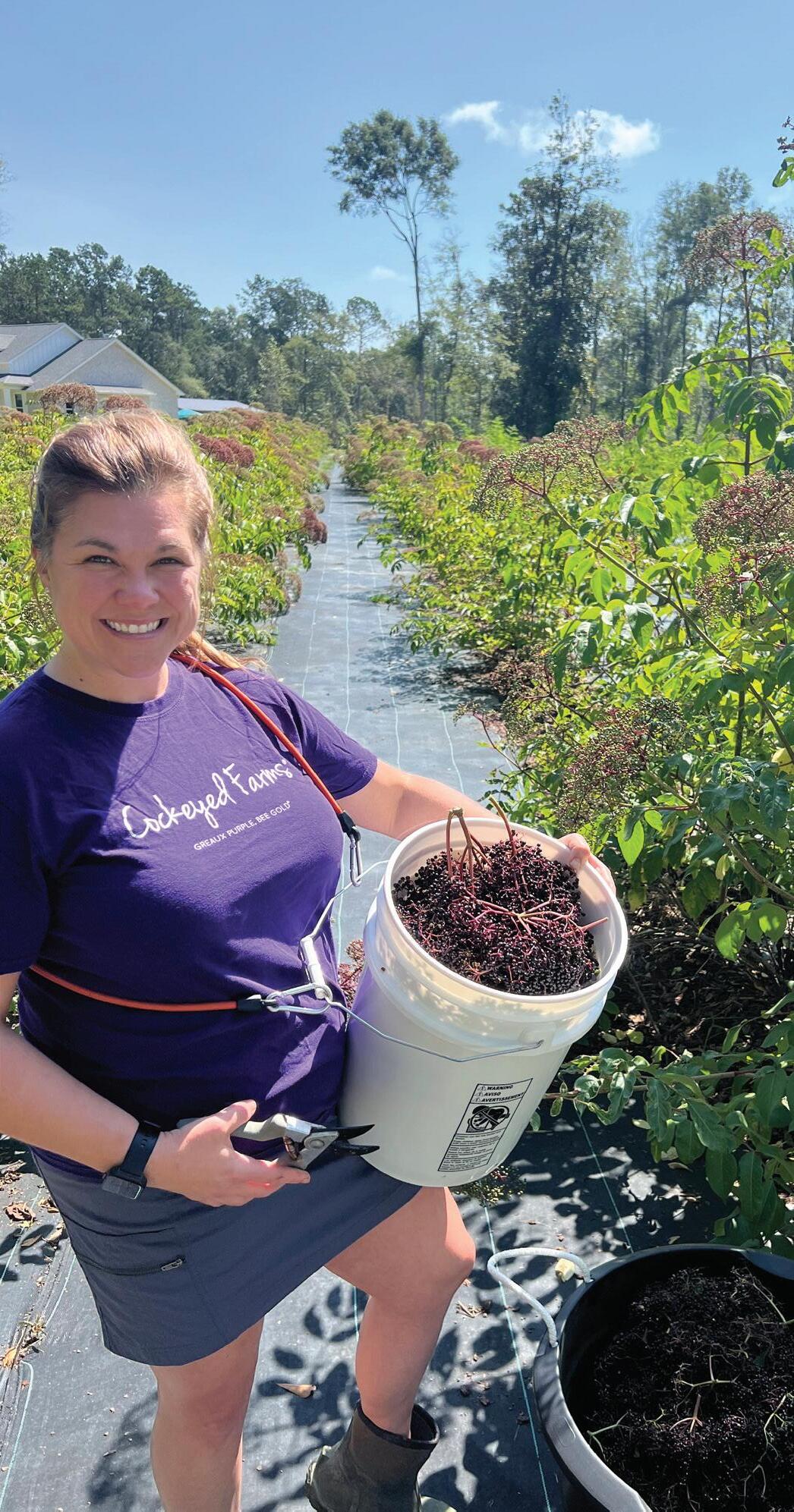
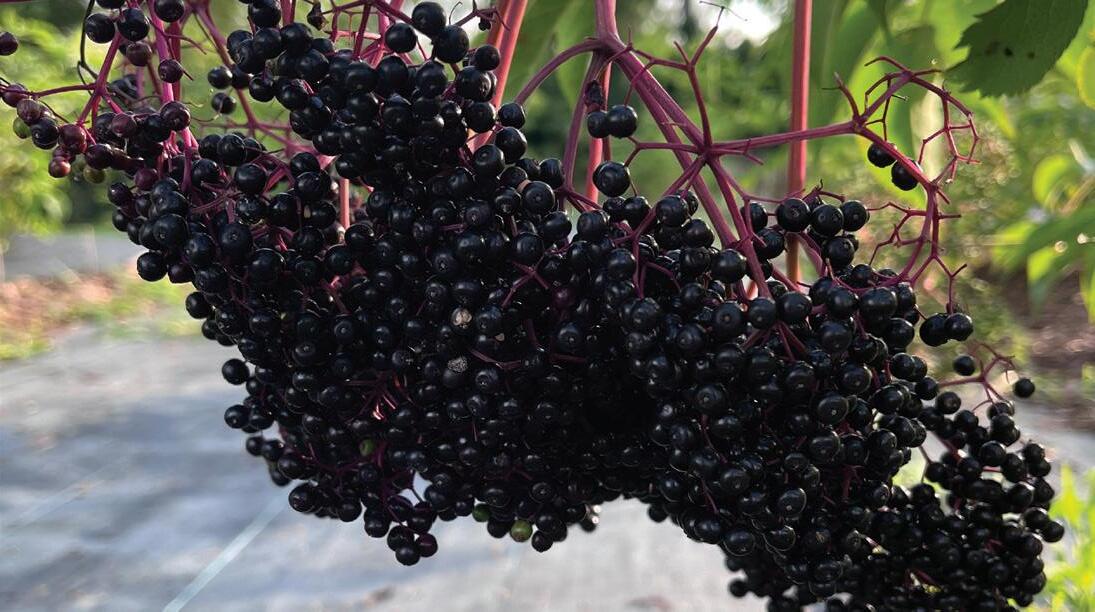
PHOTOS COURTESY OF COCKEYED FARMS

Unplug and Play








Use family fun to teach kids the power of energy conservation
By Drew Woolley










ages, cooperatives have learned a few helpful tricks to resonate with younger audiences. Hands-on activities, such as asking kids to look through their backpacks for electronic devices and calculating how much energy they use, can drive home just how much electricity they use in their daily lives. Meanwhile, avoiding technical terms like “energy efficiency” can help saving energy feel less daunting and more fun.

Everyone likes finding ways to save on their energy bill. But watching the thermostat like a hawk, turning off lights behind everyone in the house and sweating an investment in energy-efficient appliances isn’t much fun, especially when you’re trying to get the kids to play along. Fortunately, electric cooperatives have been working to make energy savings more approachable for many years. After decades of educating kids of all







AIGENERATED ILLUSTRATION
BY FREEPIK/BRANDON POMRENKE


Even so, some of the most effective ways to drive home the importance of energy conservation are the routine reminders members may have heard from their parents growing up. Luckily, there are still plenty of ways to teach your kids the importance of energy conservation while having fun as a family.





Here are some fun ways to encourage energy efficiency and conservation at home: Cook a family-powered dinner. Have the whole family help cook dinner with one rule: No electricity is allowed. Avoid using major kitchen appliances like electric ovens, blenders, mixers or
microwaves to teach kids about common ways your family uses electricity during peak demand times. Top it all off with some no-bake treats.




Take turns on power patrol. Every child enjoys being in charge from time to time. Take turns letting everyone in your family be responsible for enforcing good energy habits around the house for a week. You can even set up a point system for every time they notice a light left on in an empty room, unplug unused electronics chargers or adjust the thermostat to a more efficient setting. Offer prizes and rewards to encourage them to be mindful of energy use every day.








Build an energy-efficient dream home. Encourage everyone to design their dream home with energy-saving features in mind. This is a great way to introduce ideas like solar panels, efficient appliances and sustainable building materials. Break out the crayons and art supplies to bring their homes to life, or use household crafts to build models.











Play energy-saving bingo. Make bingo cards with squares for energysaving actions like using natural light instead of lamps or ceiling lights, unplugging devices, turning off lights and cooling off the temperature by opening a window. Kids can cross out each square as they complete each task, and the first one to bingo gets a prize.








Have power-free fun. Designate one night a week as power-free time when everyone in the family turns off phones, computers and TVs together. Play a board game, spend time reading your favorite books or enjoy some outdoor activities technology-free. Save on your electric bill, teach the importance of reducing energy use during peak periods and get some valuable family time all at once.




Make an energy-saving scavenger hunt. Make up a list of energy-saving practices, such as updating light fixtures with LED bulbs, turning off lights in empty rooms and unplugging





unused devices. Challenge your kids to search the house and check off an example of each scavenger hunt item. You can celebrate with small prizes or treats for each energy-efficient discovery they make along the way.






Create energy-efficient art. Kids enjoy seeing their artwork displayed, so put those creative skills to work on energy-efficient reminders around the house. Spend arts and crafts time teaching your kids about some of the steps they can take to save energy around the house. Make fun signs to serve as daily reminders to close the fridge quickly, turn off lights and only change the thermostat as a last resort.






every time someone spots an unused device still plugged in. Set a goal and reward yourselves when everyone keeps phantom energy use down. No matter what you do to keep energy savings fun around the house, the most important part of instilling good habits is reliably reminding your family of the little steps they can take to be more efficient. Consistency is key.




Keep “phantom power” waste bottled up. Phantom energy—the electricity devices use even when they are turned off— can be a tricky concept for kids to understand. Illustrate it in a fun way by adding marbles to a glass bottle or jar























